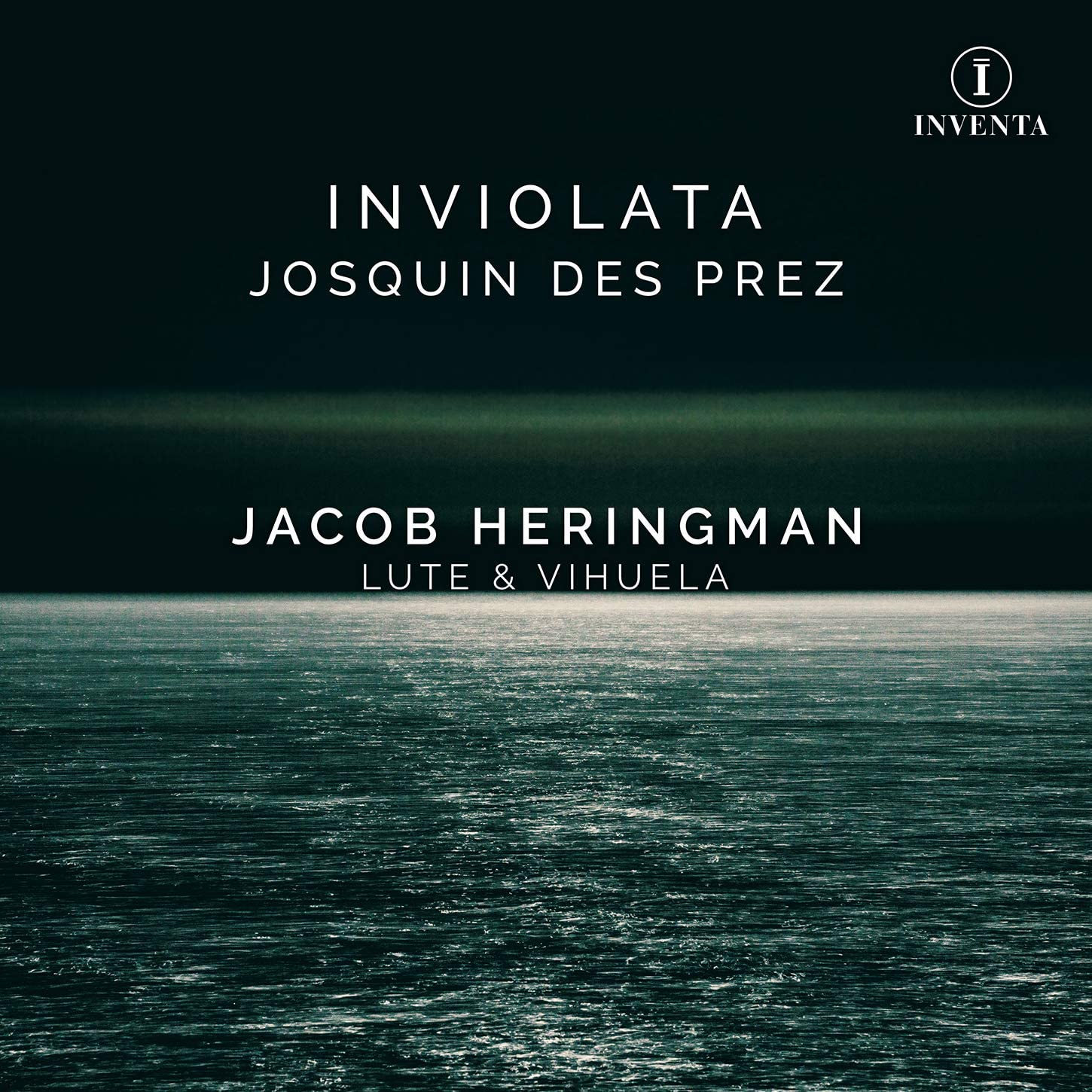Jacob Heringman lute & vihuela
65:07
Inventa INV1004
Click HERE to buy this on amazon.co.uk
There have been many excellent recordings of lute music in recent years, and Jacob Heringman’s new CD of music by Josquin Des Prez (c.1450/1455-1521) is surely up with the best of them. Josquin’s music is sublime, and is enhanced by Heringman’s unhurried interpretation. There are no foot-tapping dance rhythms, no complex fantasies to amaze with virtuosity. This is sacred music – Marian motets – by arguably the finest composer of his generation, and with it Heringman succeeds in creating a sound world of inner peace and serenity.
Lute intabulations are more than merely re-writing music in tablature. Skill is required in deciding which notes to include, which to leave out, and which to decorate. In some cases, lutenists would use material from a vocal original as a starting point for creating an entirely new composition – a prelude or a fantasia.
In his excellent liner notes Heringman writes: “We know very little of the circumstances in which lute intabulations were played but they require a calm, small space, a refuge from the outside world where one might contemplate an inner one.” Such a place is St Cuthbert’s Chapel at Ushaw, where the recording was made. Its warm, clear acoustic is ideal for the lute. Heringman maintains that today’s lutenists should be as creative as their forebears were 500 years ago, and add something of their own to the music they play, rather than always slavishly recreate note for note the intabulations of others.
The CD begins with Heringman’s own intabulation of Josquin’s Ave Maria, gratia plena, Dominus tecum, Virgo serena. It is a long piece – just short of nine minutes. All four voices are included in the intabulation. Heringman sustains it well, with tastefully restrained divisions, as it works its way through contrasting sections. The motet ends with some very slow chords for the words “O Mater Dei, memento mei. Amen”, not actually sung, of course, but imagined through the lute. Heringman uses a lute in E built by Michael Lowe, the lower pitch adding a certain gravitas.
Using the same lute, there follows an intabulation by Hans Gerle (published in 1533) of Josquin’s 5-voice Inviolata, integra et casta es. There are three sections. Gerle extends the range of the lute by tuning the 6th course down a tone for the sake of including all the low F’s. Alternative solutions could have been to omit them, include them an octave higher, or transpose all voices up a tone, which would set the piece uncomfortably high on the fingerboard of the lute. Re-tuning the sixth course of the lute seems the best option to me, although it results in some pretty weird chord shapes. Gerle omits some long notes, particularly where two voices are close in pitch. Almost all the divisions decorate the top part. They are for the most part formulaic and predictable, but nevertheless effective in sustaining the overall sound.
Heringman plays tracks 5-10 on a vihuela in G by Martin Haycock. The lute and vihuela share the same tuning, and often it is possible for the same music to be played on either instrument. However, apart from the obvious difference in body shape, there is another important difference: the strings of the lute are spaced closer at the nut than they are at the bridge, whereas the strings of the vihuela are close to parallel. Parallel stringing helps with awkward stretches high up the neck, and enables a vihuelist intabulator to make fewer compromises in tracking the original voice parts. The shorter string length of Heringman’s vihuela also helps with difficult chords.
Tracks 5-11 are derived from Josquin’s Missa de Beate Virgine. First is an intabulation by Alonso Mudarra (c.1510-1580) of Kyrie I, which has sections marked “Josquin” (for example, the last nine bars) to show where the intabulation closely follows Josquin’s original, and “Glosa” for extra material added by Mudarra. For Kyrie II Heringman turns to another vihuelist, Enriquez de Valderrábano (fl. 1547), but rather than use the note-for-note intabulation on folio 85r of Silva de Sirenas, he plays Valderrábano’s Fantasia on 73v which parodies Josquin’s Kyrie II (Fantasia remedada al chirie). In a similar vein, Heringman includes a short prelude of his own based on Mariam coronans from the same mass.
For the last track of music associated with Josquin’s Missa de Beate Virgine Heringman plays an intabulation of Cum sancto spiritu by Hans Neusidler (c. 1508/9-1563) printed in Der ander theil des Lautenbuchs (1536). It tracks Josquin’s vocal original quite closely, with divisions added mainly to the top part, but not exclusively so. Neusidler’s divisions in this volume are faster and more complex than those in his earlier volume – Ein Newgeordent Künstlich Lautenbuch – and there are some semiquavers here and there. As with other intabulators working long after Josquin’s death, Neusidler sharpens some notes and modernises cadences, so Josquin’s archaic endings of submediant-tonic are altered to leading note-tonic, usually with fast divisions. The piece ends – as do many German intabulations – with an extra flourish to a reiterated final chord.
In his liner notes Heringman argues a strong case for modern-day lutenists not always to follow slavishly intabulations of the past, but be creative and make up their own. This he does to good effect in his own intabulation of Josquin’s Salve Regina. The CD ends with an intabulation of Josquin’s Stabat Mater by Simon Gintzler (c.1500 – after 1547). Heringman gives a sensitive performance of Josquin’s touching portrayal of the inexplicable grief experienced by Mary watching her son die in agony on the cross.
Stewart McCoy

One reply on “Josquin: Inviolata”
An excellent and highly informative review – thank you, Mr McCoy. I fully agree with your opinion as to the value and importance of this recording.